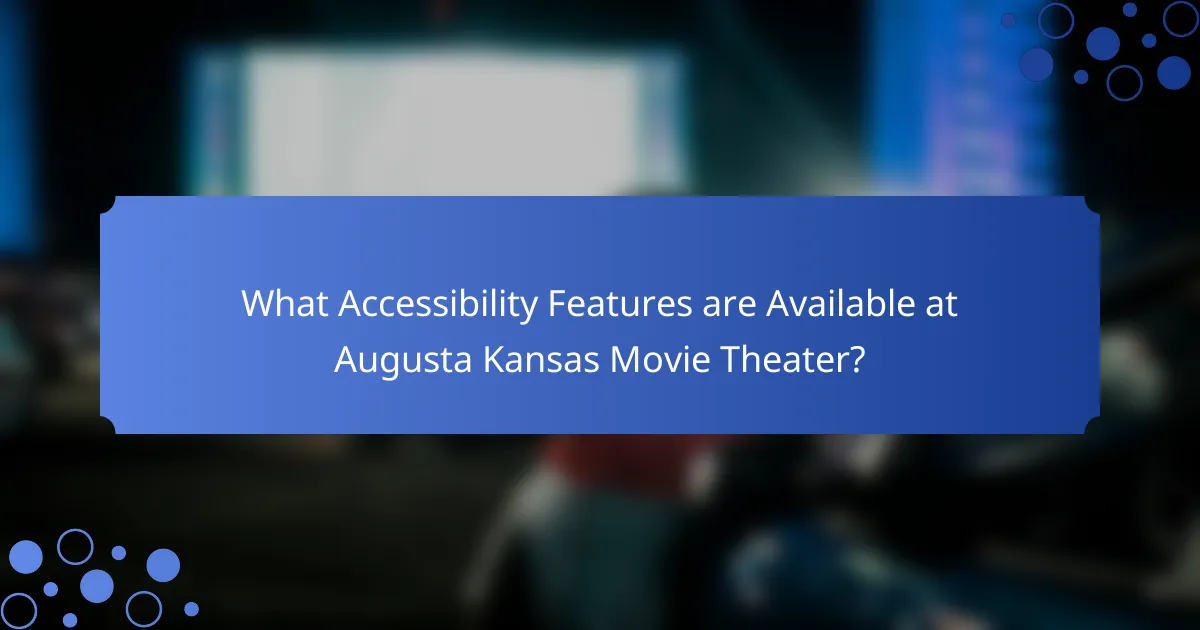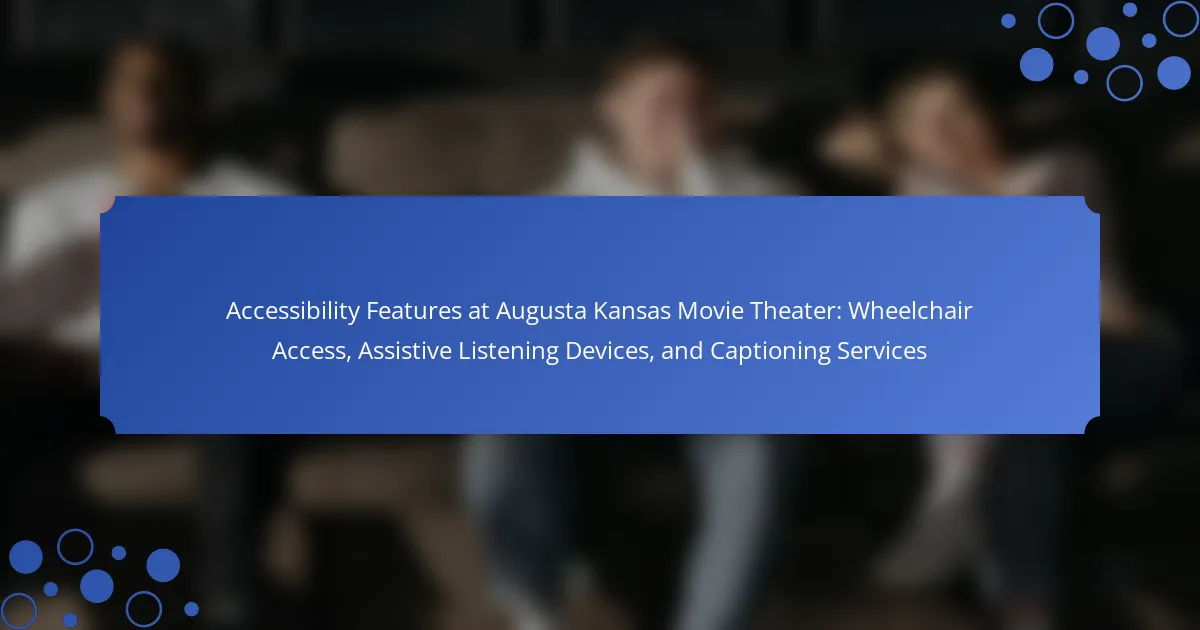The Augusta Kansas Movie Theater is equipped with several accessibility features designed to enhance the experience for all patrons. Key offerings include wheelchair access, allowing individuals with mobility challenges to navigate seating areas comfortably. The theater also provides assistive listening devices that amplify sound for guests with hearing impairments, as well as captioning services for select films to support individuals who are deaf or hard of hearing. These features reflect the theater’s dedication to ensuring an inclusive environment for every visitor.

What Accessibility Features are Available at Augusta Kansas Movie Theater?
The Augusta Kansas Movie Theater offers several accessibility features. These include wheelchair access for individuals with mobility challenges. The theater is designed to accommodate wheelchairs in seating areas. Additionally, assistive listening devices are available for guests with hearing impairments. These devices amplify sound to enhance the viewing experience. Captioning services are also provided for select films. This ensures that individuals who are deaf or hard of hearing can enjoy the movie. These features demonstrate the theater’s commitment to accessibility for all patrons.
How is Wheelchair Access Implemented at the Theater?
Wheelchair access at the theater is implemented through designated seating areas and ramps. These areas are specifically designed to accommodate wheelchair users. The theater provides accessible entrances equipped with ramps and automatic doors. Additionally, restrooms are modified for wheelchair accessibility. Staff members are trained to assist patrons with mobility needs. The theater also ensures clear pathways for safe navigation. Compliance with the Americans with Disabilities Act (ADA) standards is maintained. Regular audits are conducted to assess accessibility features.
What specific accommodations are provided for wheelchair users?
The Augusta Kansas Movie Theater provides several specific accommodations for wheelchair users. These include designated wheelchair-accessible seating areas. The theater ensures that these seats offer clear sightlines to the screen. Additionally, there are accessible restrooms available nearby. The venue also features ramps for easy entry and exit. Staff are trained to assist wheelchair users as needed. These accommodations comply with the Americans with Disabilities Act (ADA) standards. The theater aims to create an inclusive environment for all patrons.
How does the theater ensure safe navigation for individuals with mobility challenges?
The theater ensures safe navigation for individuals with mobility challenges by implementing various accessibility features. It provides ramps and elevators to facilitate movement between levels. Accessible seating areas are designated for easy access. Clear signage guides individuals to accessible routes. Staff members are trained to assist those who need help. The layout is designed to minimize obstacles in pathways. These measures comply with the Americans with Disabilities Act (ADA) standards. Regular assessments ensure the effectiveness of accessibility features.
What Assistive Listening Devices are Offered?
The Augusta Kansas Movie Theater offers several assistive listening devices. These devices include portable listening systems and hearing loop technology. Portable systems typically consist of a transmitter and receiver. They amplify sound directly to the listener’s device. Hearing loop technology uses electromagnetic fields to transmit sound. This technology connects directly to hearing aids equipped with telecoils. The availability of these devices enhances the movie experience for individuals with hearing impairments. They ensure clear audio without background noise interference.
How do Assistive Listening Devices enhance the movie experience?
Assistive Listening Devices enhance the movie experience by improving audio clarity for individuals with hearing impairments. These devices amplify sound directly from the movie’s audio system. They reduce background noise, allowing users to focus on dialogue and sound effects. Many theaters provide these devices free of charge or for a nominal fee. Research shows that 48 million Americans experience hearing loss, making these devices crucial for inclusivity. Studies indicate that users report higher satisfaction and engagement when using Assistive Listening Devices during films. This technology ensures that everyone can enjoy the full cinematic experience.
What types of Assistive Listening Devices are available at the theater?
The theater offers several types of Assistive Listening Devices. These include personal listening devices, which amplify sound directly to the listener. There are also infrared listening systems that transmit audio through infrared light. Additionally, the theater provides FM systems that use radio waves for sound transmission. Hearing loop systems are available as well, allowing users with compatible hearing aids to connect directly to the audio system. These devices enhance the experience for patrons with hearing impairments. Each type is designed to improve sound clarity and accessibility during performances.
What Captioning Services are Provided for Moviegoers?
Moviegoers are provided with open captioning and closed captioning services. Open captioning displays text on the screen for all viewers. Closed captioning requires special devices to view text, which is only visible to the user. Both services enhance accessibility for individuals with hearing impairments. The use of these services complies with the Americans with Disabilities Act (ADA). Many theaters also offer captioning via personal devices or through specific screenings. This ensures that all audiences can enjoy the movie experience equally.
How do captioning services improve accessibility for the hearing impaired?
Captioning services improve accessibility for the hearing impaired by providing written text of spoken dialogue and sound effects. This allows individuals who are deaf or hard of hearing to understand the content of movies and videos. Captioning services also include descriptions of non-speech audio, enhancing the viewing experience. According to the National Association of the Deaf, approximately 15% of Americans experience some degree of hearing loss. With captioning, these individuals can enjoy films and media on the same level as their hearing peers. Additionally, captioning promotes inclusivity by ensuring that everyone has equal access to information and entertainment.
What formats of captioning are available during screenings?
The formats of captioning available during screenings include open captions and closed captions. Open captions are permanently displayed on the screen and cannot be turned off. Closed captions can be toggled on or off by the viewer. Both formats provide essential dialogue and sound descriptions for individuals who are deaf or hard of hearing. The availability of these formats enhances accessibility in movie theaters. According to the National Association of the Deaf, closed captions are a vital tool for ensuring equal access to film content.
How do Accessibility Features Impact the Overall Movie Experience?
Accessibility features significantly enhance the overall movie experience for individuals with disabilities. These features ensure that everyone can enjoy films without barriers. Wheelchair access allows individuals with mobility impairments to navigate the theater comfortably. Assistive listening devices provide clear audio, ensuring that those with hearing loss can follow the dialogue. Captioning services offer visual text of spoken dialogue, making films accessible for the deaf and hard of hearing. Research shows that inclusive environments increase audience satisfaction and engagement. The implementation of these features leads to a more equitable viewing experience for all patrons.
What are the Benefits of Accessibility Features for the Community?
Accessibility features benefit the community by promoting inclusivity and ensuring equal access to public spaces. These features allow individuals with disabilities to participate fully in social activities. For instance, wheelchair access enables those with mobility challenges to enjoy venues like theaters. Assistive listening devices enhance the movie experience for individuals with hearing impairments. Captioning services provide essential information for the deaf and hard of hearing communities. Studies show that inclusive environments lead to higher community engagement. According to the American Community Survey, approximately 12.6% of the U.S. population has a disability, highlighting the need for accessible features. By implementing these features, communities foster a sense of belonging and support diversity.
How do these features promote inclusivity and diversity in film viewership?
Accessibility features such as wheelchair access, assistive listening devices, and captioning services promote inclusivity and diversity in film viewership by ensuring that all individuals can enjoy the cinematic experience. Wheelchair access allows people with mobility challenges to enter and navigate the theater comfortably. Assistive listening devices cater to those with hearing impairments, enabling them to engage with audio content effectively. Captioning services provide visual text for dialogue and sounds, making films accessible to individuals who are deaf or hard of hearing. These features collectively remove barriers that often limit participation in film viewership. According to the National Association of the Deaf, captioning increases audience engagement and comprehension for all viewers, not just those with disabilities. By implementing these features, theaters demonstrate a commitment to inclusivity, fostering a diverse audience that reflects a broader community.
What Tips Can Enhance Your Experience with Accessibility Features?
To enhance your experience with accessibility features, familiarize yourself with the available options. Understanding wheelchair access points can improve navigation within the theater. Utilize assistive listening devices for clearer audio. These devices can amplify sound tailored to individual needs. Opt for captioning services to follow dialogue easily. This feature benefits those with hearing impairments. Arrive early to secure preferred seating and test equipment. Engaging with staff can provide additional assistance and information. Familiarity with these tips can lead to a more enjoyable movie experience.
The Augusta Kansas Movie Theater is committed to accessibility, offering features such as wheelchair access, assistive listening devices, and captioning services. Wheelchair access includes designated seating, ramps, and modified restrooms, ensuring compliance with ADA standards. Assistive listening devices enhance audio clarity for patrons with hearing impairments, while captioning services provide essential dialogue text for deaf and hard of hearing individuals. These accessibility features promote inclusivity, allowing all community members to enjoy the cinematic experience without barriers.
